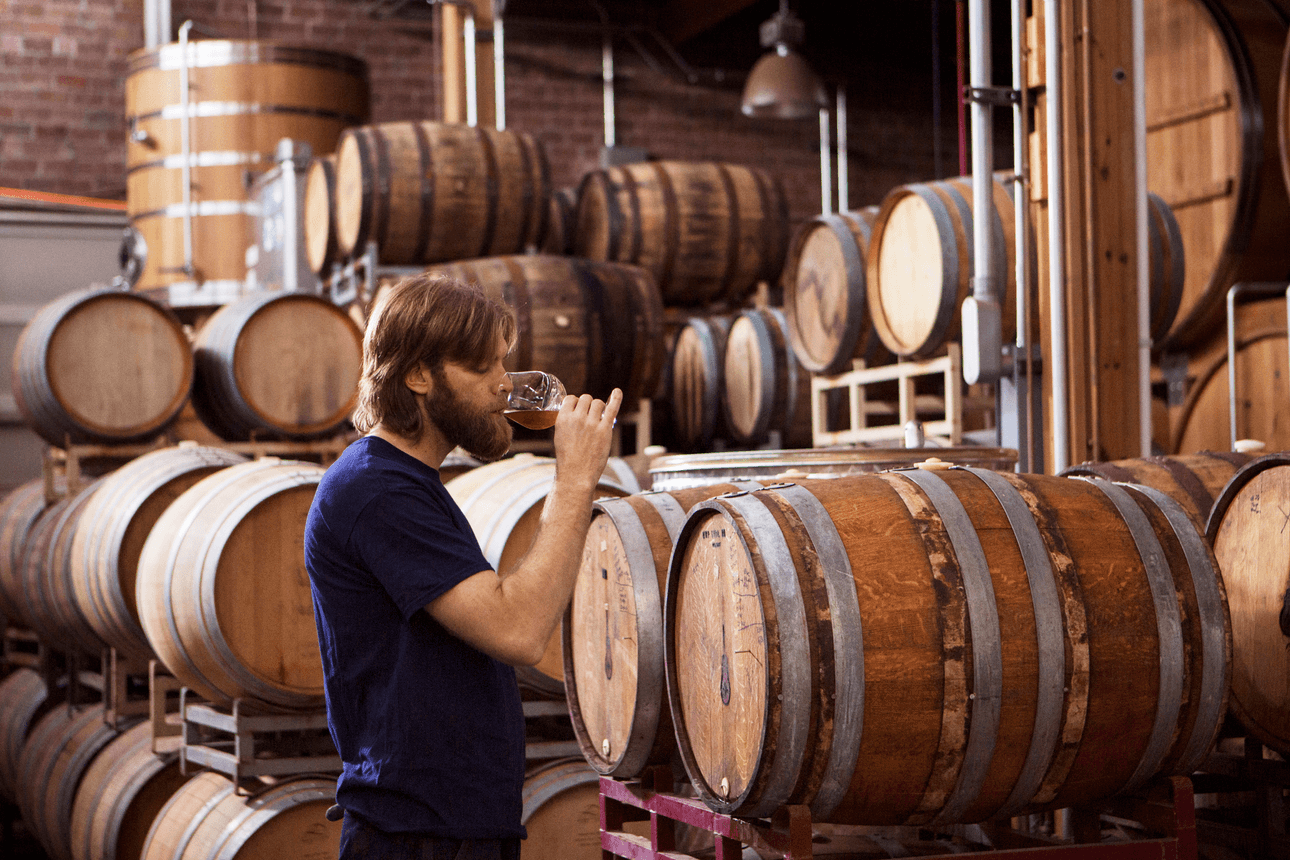Two beer experts share their tips for making the most of your brew, from how to store your bottles to the best kind of glasses to use.
Too many of us aren’t treating our beer with the love, care and attention it deserves. It starts with the lack of respect we often have for beer, a belief it’s an inferior species to other drinks. While we swirl and sniff our pinot noir from a wide-bodied glass to allow the delicate flavours of the lighter red wine to hit the tip of the tongue, we’re far too happy to drink beer straight from the bottle or can – removing all the joy that comes from the nose of the beer, and the majority of its vast flavours.
While we store our wine in a cellar, we’ll let a box of beer sit in the boot of a hot car until it’s thrown in a chilly bin with some ice. And then we drink it too cold, suppressing some of the best flavours the brew has to offer. Pouring beer is also an art; not one to suppress the foam but to release it, setting off the beer’s aromas and creating a textural experience that you can’t get without a good head on your beer.
So, it’s time to R E S P E C T your beer. And to help you the Spinoff spoke to two passionate beer drinkers (who have a bit of brewing experience too) about how to treat your next beer right. By learning just a few basic tricks and rules around how to serve and store your beer you can reveal a beauty you didn’t know existed.
Treat your beer like food
“Beer is a complex and beautiful drink that often has a range of subtle flavours, aromas and textures that can be enhanced by serving it correctly,” says Natasha O’Brien, Brewing Manager at DB’s Waitemata Brewery. An internationally recognised beer judge, O’Brien is passionate about celebrating and protecting these intricacies.
“On the other hand, these subtleties can be spoilt if you don’t look after beer and store and serve it in the right way.”
Treating your beer like food is the first bit of advice from Donald Nelson, who worked at Lion for 37 years, across brewing and technical roles. For one year he was president of the international industry innovation and education body, the Institute of Brewing and Distilling.
“The general things you do with food, you do with your beer: how you store it, have it fresh, how you look after it, you do it the same for beer,” he says.
In the same way you wouldn’t buy meat weeks before hosting a barbecue, rushing around buying your beer six months before an event because it’s on special is a bad idea, he says. Nelson ideally likes to drink his beer when it’s less than a month old.
As beer gets older its flavour and texture start to decline. It loses its freshness, its sharpness and vibrance. Breweries go to great effort to prevent the impacts of the environment on beer, but it’s a fragile, delicate beverage and is prone to oxidation and vulnerable to the sun. Both will negatively impact the full sensory experience of the beverage and can add an array of unflattering flavour characteristics.
“If you pour a glass of Steinlager Classic into a clear glass and leave it in the sun for 20 minutes, and pour a fresh to compare, the smell is quite distinctly different,” says Nelson.
“Sun strike can bring out the “skunky” flavours. If you are aware of light strike you can smell it across the room.”
Again, think about food when looking after your beer, and store it somewhere that keeps it fresh.
“I would always suggest storing beer in a fridge, or a cool dark place. Light and heat are the enemies of beer, negatively transforming the flavours and appearance,” says O’Brien.
Now your beer’s flavour is safely protected from oxygen and sunlight it’s time to serve it right.
A glass half full
To get the full experience of a beer’s flavour it needs to be from a glass. Drinking from a can or bottle, while convenient, physically restricts your ability to enjoy a beer’s full flavour profile: most of which comes from its nose. Food tastes different when your nose is blocked, sometimes it tastes like nothing at all. Drinking beer straight from the bottle is like eating with a blocked nose. When you drink from a glass your nose enters the vessel itself giving you access to the full flavour experience.
“The vast majority of the 250-plus active flavour ingredients you smell. There’s only four or five you taste on your tongue,” says Nelson.
“If you’re there to taste, using your smell gives you the optimum. That’s why I always use a glass. If you’re using a can or a bottle your nose is taken out of the equation.”
A head start
Not only does a glass give you access to a beer’s full flavours, but it allows you to release the full potential of the beverage – the head. The foamy topping is essential to the drink’s texture and is also an important layer of protection for the liquid against the elements.
“A good head on a beer is really important” says O’Brien. “The head locks in the CO2, keeping the beer fresher for longer. Once oxygen connects with the beer it will start losing flavour, carbonation and temperature.”
Getting a good head starts with having a good glass – and special washing detergent. Most household detergents are “foam negative” and this causes the head to collapse. While pubs use specific detergent and machines to ensure the glasses will harness the head, at home you’ll need to find a dishwashing detergent that doesn’t destroy your beer’s foam.
“I wash my glasses in a domestic dishwasher and use a detergent that isn’t strongly foam negative. If the mischievous residents of my house wash my beer glasses in the sink, I will take them and put them in the dishwasher,” says Nelson.
The next step is the pour. You don’t need to fill the glass in one pour, keep topping it up from the bottle or can, refreshing the head, and keeping the liquid protected from sun strike (brown glass, followed by green glass, keeps out the sun much better than clear). Tip the beer from a 45-degree angle and don’t be shy, you want a strong pour and hard contact with the glass to create the head. O’Brien aims for a two-finger width layer of foam, and Nelson describes a centimetre as “conservative”.
Where is that drink taking you? Higher places if you do it right
Once it’s in your glass (with a nice head), you can start the taste experience. The first thing O’Brien does with her beer is analyse its colour.
“Within the liquid, I look for a bright colour, take notice of the clarity and observe the carbonation,” she says.
As Nelson drinks his beer, he constantly swirls the beverage, a motion that releases the flavours. He then dips his nose in the glass and takes a long sniff. He’s looking for the malt flavours, how much yeast is present, and hop notes. Then when he takes a sip he breathes in at the same time – like a less exaggerated version of a wine taster’s slurp – to release the volatiles.
“You’ll find the malt flavours at the front, bitterness at the back. It comes late, 30 seconds after your sip is the peak perception of flavour. You’ll be left with bitterness cleaning the palate, a dry sensation in the mouth,” he says.
Don’t forget to think about the texture too. O’Brien is looking for several tactile qualities from her beer.
“When I take a sip, I not only think about the flavours (like how the malt balances with the bitterness of hops), but also the ‘mouth feel’ and the carbonation,” she says.
Beer diplomacy
Humans have been drinking beer for 5000 years and it’s always been a social drink that brought people together. Donald Nelson likes to argue that homo sapiens used yeast to make beer before bread. Another fact Nelson is fond of is that one of the first things written down on clay tablets was a recipe for beer. He tells me about its original form as a communal drink resembling a runny porridge. It was a fermented cereal, and everyone sat around with straws and drank from the same bowl.
This communal part of beer is still essential to its place in New Zealand’s culture. A good yarn makes a beer better every time.
“The number of times I’ve solved the world’s problems of a few jars at the pub is innumerable,” says Nelson.
Seeing as there appear to be a few outstanding global issues now is the perfect time for a beer. Just make sure you do it with the respect it deserves.
This content was created in paid partnership with the Brewers Association. Learn more about our partnerships here.

